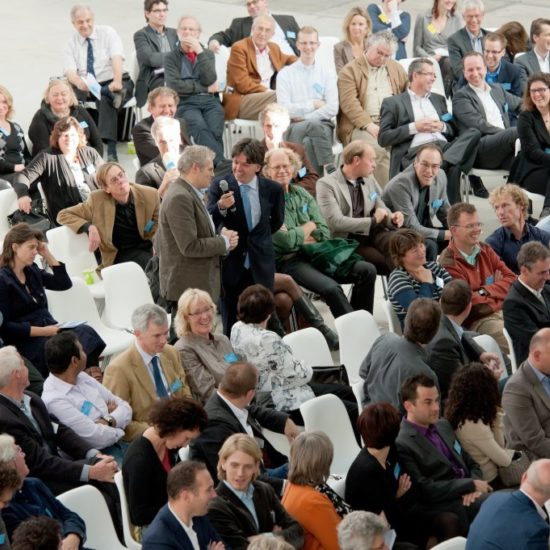Content networking
Often networking is a separate part of the programme and that is a pity (both online and on stage). You can also integrate networking in the content.
It's actually very simple: every time you plan interactive moments where participants get to talk to each other, that is also networking. They get to know each other and the good thing is: the awkward silences immediately belong to the past, because you send them on their way with a conversational assignment.
Just make sure that people can immediately exchange contact-information in one way or another.
Guided networking
Even more than in real life, online it is a huge step to (virtually) walk up to someone and start a conversation. But even in a live setting, many people find it difficult to enter the networking arena. It therefore works very well to deliberatly design those moments.
You really help the participants a lot if you establish a clear goal in advance, why we are going to network in the first place. Then come up with dialogue and connection formats and let a moderator guide them.
By using guided conversational/networking formats, if only part of the time, you help participants to open the conversation in a natural way and to find the right people to talk to.
Platform
Always look for the most appropriate platform or tool. Sometimes this can be done within your event platform (like Zoom, Teams or something completely different) and many platforms have their own networking tools.
But sometimes you have very specific requirements and goals. Then it might make sense to look for a solution that does exactly what your meeting needs. There are some really cool options on the market. Think for example of Twine, MiBo, Gatherly or Remo. Or look for candidates we don't know about yet (and please let us know about them!).
Use technology wisely
More and more apps are appearing on the market that help make networking and matchmaking easier. Make sure you use these fantastic options. But do not fall into the trap of only relying on the digital possibilities. That brings the risk that people lock themselves up in their phones and then make less real human contact.
Therefore, also think of great analogue networking and matchmaking activities. Alternate between digital and analogue and really bring participants into touch with each other.
Change group sizes
Everyone feels more comfortable in different types of groups. Some people only thrive in a one-on-one conversation in an intimate atmosphere. Others go best on high energy in somewhat larger groups. Therefore, make sure there is something for everyone.
Alternate the completely open reception with 100 people in a room with activities in groups of 2, 4 or 8.
Think about the introverts
For some people networking is even more challenging than for others. Don't forget that a large part of your participants are introverts.
So design your networking moments in such a way that this group can participate as well. Provide intimate corners, do matchmaking, create a safe atmosphere and start small.
Choose!
Networking takes many shapes and forms: completely serendipious, completely guided and everything in between. All forms have advantages and disadvantages. Think about what you want to achieve with the networking and choose the right format accordingly.
Design
Networking is not something that happens spontaneously, as long as you get enough people together in a room. You have to take control and make it happen!
Help your participants to actively engage in conversation, instead of handing them over to a group of strangers. Give your participants something to hold on to, instead of letting them wander around miserably.
Jan-Jaap In der Maur


